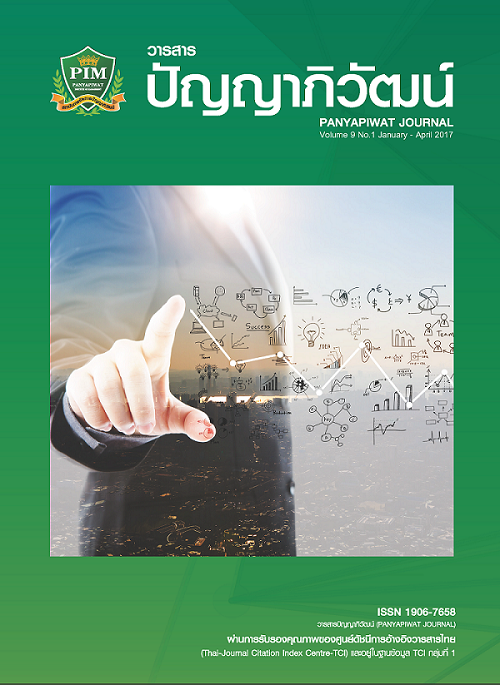การเปรียบเทียบผลตอบแทนของแรงงานของบริษัทไทยกับบริษัทต่างประเทศในอำเภอสะเดา จังหวัดสงขลา
Main Article Content
บทคัดย่อ
การศึกษาครั้งนี้มีวัตถุประสงค์เพื่อเปรียบเทียบผลตอบแทนและระดับปัญหาและอุปสรรคของผลตอบแทนของแรงงานในบริษัทไทยกับบริษัทต่างประเทศ โดยเก็บรวบรวมข้อมูลจากแรงงานที่ทำงานในบริษัทไทยและบริษัทต่างประเทศ อย่างละ 200 ตัวอย่าง สถิติที่ใช้ในการวิเคราะห์ ได้แก่ ความถี่ ร้อยละ ค่าเฉลี่ย ค่าส่วนเบี่ยงเบนมาตรฐาน และการทดสอบค่าเฉลี่ยของกลุ่มตัวอย่าง 2 กลุ่มที่มีความเป็นอิสระต่อกัน (Independent Sample T-test) ผลการศึกษาพบว่า ค่าเฉลี่ยของวันหยุดบริษัทต่างประเทศมากกว่าบริษัทไทย ซึ่งแตกต่างกันอย่างมีนัยสำคัญทางสถิติที่ระดับ 0.00 โดยวันหยุดเฉลี่ยของบริษัทต่างประเทศ 29.56 วัน/ปี และบริษัทไทย 23.74 วัน/ปี ในส่วนของระดับปัญหาและอุปสรรคของผลตอบแทนของแรงงานในบริษัทต่างประเทศมีระดับปัญหาและอุปสรรคที่น้อยกว่าบริษัทไทย ซึ่งแตกต่างกันอย่างมีนัยสำคัญทางสถิติที่ระดับ 0.00 โดยค่าเฉลี่ยระดับปัญหาและอุปสรรคของบริษัทต่างประเทศ 1.55 ซึ่งอยู่ระดับน้อยที่สุดและบริษัทไทย 1.91 ซึ่งอยู่ระดับน้อย
This study was aimed to compare the compensation and the level of compensation’s problems for workers between Thai and Foreign companies in Sadao district, Songkhla province. The data were collected from 200 workers in each type of company. The study employed frequency, percentage, mean, standard deviation, and Independent Sample T-test to analyze the data. The results revealed that company types significantly provided different holiday to their workers. The means of holiday per year were 29.56 and 23.74 for the foreign and Thai company respectively. Average level of compensation’s problems was foreign company less than Thai company that was significance. The means of average level of compensation’s problems for the foreign company was 1.55 that was least level and the Thai company was 1.91 that was less level.
Article Details
“ข้าพเจ้าและผู้เขียนร่วม (ถ้ามี) ขอรับรองว่า บทความที่เสนอมานี้ยังไม่เคยได้รับการตีพิมพ์และไม่ได้อยู่ระหว่างกระบวนการพิจารณาลงตีพิมพ์ในวารสารหรือแหล่งเผยแพร่อื่นใด ข้าพเจ้าและผู้เขียนร่วมยอมรับหลักเกณฑ์การพิจารณาต้นฉบับ ทั้งยินยอมให้กองบรรณาธิการมีสิทธิ์พิจารณาและตรวจแก้ต้นฉบับได้ตามที่เห็นสมควร พร้อมนี้ขอมอบลิขสิทธิ์บทความที่ได้รับการตีพิมพ์ให้แก่สถาบันการจัดการปัญญาภิวัฒน์หากมีการฟ้องร้องเรื่องการละเมิดลิขสิทธิ์เกี่ยวกับภาพ กราฟ ข้อความส่วนใดส่วนหนึ่งและ/หรือข้อคิดเห็นที่ปรากฏในบทความข้าพเจ้าและผู้เขียนร่วมยินยอมรับผิดชอบแต่เพียงฝ่ายเดียว”
เอกสารอ้างอิง
Chasombat, P. et al. (2003). Establishing metrics and models in the demand for labor in manufacturing sector. Bangkok: Applied Economics. Faculty of Economics, Kasetsart University. [in Thai]
Chowarit, S. (1984). Social welfare: Evolution of Social Welfare. Khon Kaen: Khon Kaen University. [in Thai]
Chutiwong, N. (2005). Principle of Economics 1: Microeconomics. Bangkok: Chulalongkorn University Publishing Company. [in Thai]
Department of Business Development. (2014). Data of Business. Retrieved November 25, 2014, from http://www.dbd.go.th [in Thai]
Hiruntho, U. (1998). Principle of Human Resource Management. Bangkok: Odean Store. [in Thai]
Jaiboon, A. (2000). Working status of Thai Workers and Migrant Workers of Textile Factories, Province. Graduate School, Chiang Mai University. [in Thai]
Kasemsin, S. (1983). New plan in Human resource management. Bangkok: Thaiwatthana Panich. [in Thai]
Office of the Civil Service Commission. (2016). Definition of Compensation. Retrieved June 6, 2016, from http:// www.ocsc.go.th [in Thai]
Phitsuwan, K. (2010). A Study on employ’s satisfaction toward welfare service of Lanna agriculture Co, Ltd. Master of Economics, Srinakharinwirot University. [in Thai]
Pitayanon, S. (1996). Labour Economics. Bangkok: Chulalongkorn University Press. [in Thai]
Promsiri, P. (1999). Employment condition and working condition of the female workers in entertainment establishments in Mueang Chiang Mai District. Graduate School, Chiang Mai University. [in Thai]
Rohathat, N. (1995). Wages and benefits of employees in the parts company’s electronic in Northern Industry. Graduate School, Chiang Mai University. [in Thai]
Ruechai, B. (2000). Human Resource Management. Bangkok: Praepittaya. [in Thai]
Sitthifong, C. (2007). Comparison of administrative styles and welfare system among American, Japanese and Thai companies in the Northern region industrial estate. Master of Science, Chiang Mai University. [in Thai]


